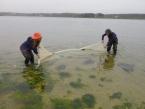The American eel, once as abundant as shellfish in Island coastal ponds and rivers and all along the Atlantic seaboard, is in such decline that the federal government is considering placing it on the list of endangered species.
On Wednesday the U.S. Fish and Wildlife Service opened a 90-day public comment period on whether to declare the American eel endangered.
Heather Bell, a senior fisheries biologist, with Fish and Wildlife, said the initiative has been coming for some time. Eels have seen a precipitous drop, not only in the United States but also in Canada. Last week, many Island tackle shops who depend on selling eels for bait were notified that Canadian eels will be in short supply this summer.
Eels are commonly used today for striped bass bait. But the Island's history is rich in eel lore.
Oak Bluffs shellfish constable David Grunden said he remembers as a teenager going to Sengekontacket Pond to harvest eels with a spear. "I used to be fairly successful. I'd find them in the eel grass in Sengekontacket Pond just before sunset. Then I would go again early in the morning."
Bret Stearns, natural resources director for the Wampanoag Tribe of Gay Head (Aquinnah) said there are still eels in Menemsha Pond and inside the freshwater streams and ponds that feed into the pond.
"There certainly are a lot less around than years ago," Mr. Grunden said.
Years ago eels were plentiful enough that they were harvested and shipped off-Island. The record books for eel trapping are filled with Island names like Benson, Bassett, Hilton, Magneson, Manter and Flanders. The Martha's Vineyard Historical Society has a collection of eel pots and traps.
A story about the Vineyard eel fishery was published in the February 1995 issue of the Dukes County Intelligencer, a quarterly magazine published by the society.
More than 20 years ago Cooper A. Gilkes 3rd of Edgartown fished commercially for eels in Katama. The late Foster Silva on Chappaquiddick did the same thing in Poucha Pond.
People ate eels, and recipes abound on the Vineyard and all along the coast.
Ms. Bell said the concern for the American eel extends as far north as Canada, and from Maine, where they are still commercially harvested, all the way down to West Virginia. With a life cycle opposite of river herring, eels spawn in the open ocean and then spend much of their lives in the fresh or brackish waters. There are at least 600 varieties of eel. The European variety is facing extinction.
Ms. Bell said the initiative to save the eel comes from a number of places. The Atlantic States Marine Fisheries Commission requested a status report on the eel back in August. The commission oversees migratory fish like striped bass. A management plan for the commercial fishing of eels was written five years ago by the commission. "They were concerned that they need to amend their management plan. At the same time they wanted the National Marine Fisheries Service to conduct a status review," Ms. Bell said.
A petition was submitted to the U.S. Fish and Wildlife Service requesting the designation.
Canada just completed its own status review, Ms. Bell said. "They are very concerned about eels coming from the Great Lakes and St. Lawrence River and last year they put a moratorium on fishing for eels in the Great Lakes."
Each summer and fall adult eels leave the coastal ponds and rivers and head to the middle of the Atlantic Ocean, where they spawn from February to April. The larvae remain in the leptocephalus stage for about a year. When they swim to the shoreline areas they look like glass eels, and are only a few inches in length. Eels move into southeastern Massachusetts coastal waters in the spring and to Maine in late spring. The elvers spend years in the freshwater estuaries. They even have the ability to climb out of the water.
Ms. Bell said the public comment period is for people who are interested in contributing data for review. "This is not a popularity contest. We are looking for biological information or commercial data," she said.
Mr. Gilkes runs a tackle shop in Edgartown. Like many other tackle shop owners on the Island, he sells eels to fishermen who like to chase striped bass. The eels he sells come from hundreds of miles away. "To me it just isn't fair. With all the science we have you would have thought they could have controlled this so we wouldn't be getting into this situation. Yes, I am upset. I am upset with the fisheries managers. Who is to say that this won't happen to striped bass? If they can't control the eels they are managing . . . . Somebody has to be looking at the overall picture. I am frustrated," Mr. Gilkes said.
Massachusetts regulates the taking of eels. Recreational anglers are limited to 50 eels a day and the minimum size is six inches. Commercial fishermen have a six-inch minimum size and no catch limit. Maine is a more significant player in the commercial fishery than Massachusetts, where the eel is in steep decline.
Ms. Bell said she expects the public comment period to draw considerable interest. If the eel is placed on the list of endangered species, it will have an impact on commercial fishing, the bait industry and even the hydropower industry. It could also draw international interest since eels are shipped overseas, particularly to Japan and Hong Kong.
"This finding is the first step in a long process that triggers a more thorough review of all the biological information available," the announcement says.
Comments may be directed to: Martin Miller, Chief, Endangered Species, Northeast Regional Office, U.S. Fish and Wildlife Service, 300 Westgate Center Drive, Hadley, MA 01035 or by electronic mail to: AmericanEel@fws.gov Comments must be received by Sept. 4.





Comments
Comment policy »